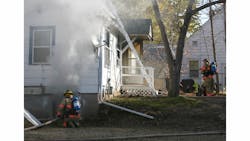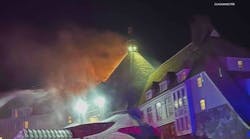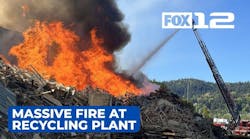There has been a lot of debate and discussion regarding modern fire dynamics and modern fire attack. While it is important to always have this in the forefront of your mind while planning an initial attack and sizing up a scene, I will play a little bit of Switzerland with the debate and stay neutral, seeing plenty of positives on both sides. One of the most important things we can do is put water on the fire as quickly as possible; whether that is through a window, through an aggressive interior attack, or straight through the Alpha-side (A-side) of a home. Putting water on the fire increases your safety on the scene and survivability of potential person(s) inside and a lot of our dangerous rescue and rapid intervention situations significantly decrease when potential for flashover is eliminated and the fire is brought under control.
This article isn’t necessarily about the recent UL and NIST studies and debating which type of attack is better. My goal is to simply look at why we so often get stuck using the A-side as our main path to fire attack when we may be better off using alternative options for just as quick and safe offensive attack.
Take just a moment and think about your structure fire experience with residential homes. Throw out commercial, multi-family, or big-box structures, and just think about residential structure fires. With 75% of fires occurring in single-family dwelling, how often do we stretch our first hoseline through the front door or A-side of the structure? When I think of my own responses, coupled with what I review and see continuously on YouTube, Firehouse.com and countless other media outlets that allow us the first-hand view of other fire attacks, I think that that number is pushing 90%, or greater.
As I review my own experiences and the countless video reviews, incident debriefings, and OSHA LODD reports, I was struck by the thought of why? Why is it that we go into the A-side almost automatically on our residential structure fires? There are countless variables that could be present to constitute the A-side approach: location of the fire, lack of ingress/egress options, size of the house and length of hose, fences, garage size (attachment/detachment), etc. But on too many occasions I see crews marching and crawling straight through the A-side when an alternative approach may improve their success on the fireground. A football team doesn’t run the same play every play in hopes they can beat the defense. They put in different plays and audible calls to be one step ahead of the defense. So, why don’t we try a different play (or audible) with whatever the fire is showing us?
Before reaching too far into this, I had to stop and ask myself: Is the A-side fire attack faster or easier? There is no straight answer. It certainly can be, but there are certainly times when it is not. There is no doubt that the A-side may appear to be the fastest route because of its proximity to your street arrival, in addition it appears the most convenient. There is a route of ingress and egress right in front of you, right? Why try another option? Though it may have convenience, though it may appear to have speed, the effectiveness of this route may not be the case for the overall firefight and for the first-arriving crews. With this in mind, I started to make a few considerations that need to be a part of the initial 360-degree size-up and considerations an initial attack crew has to make. It comes down to three main issues that work in coordination: the extent and location of the fire, smoke conditions, home layout and obstacles.
We start with the most obvious consideration with just about every fire we go on: Where is the fire? When we first arrive on-scene of a working residential fire one of our first priorities is, of course, the location and extent of the fire. Once this is determined we have to tactically react to mitigate the incident. For an example, let’s say we have a good working kitchen fire upon arrival. If it is recognized as a working fire with smoke and flame showing from the Charlie-side (C-side) of the home, what would some of the advantages (and disadvantages) of stretching the line around the exterior of the home to the C-side to make an attack?
We pride ourselves on making good interior fire attacks and this doesn’t necessarily take that option away, we can still be aggressive and interior, but just take a few extra seconds on scene to evaluate the best position and lay of the hose. With the kitchen fire example, what if your crew marched a hose-line around the outside of the home to the C-side and found a nice sliding glass door that was closer to the kitchen fire? Why not use this as your entry point, crawl into the house about three feet and make a hit on the fire. Depending on the size of the home and layout, it could be a much quicker hose-line deployment than crawling through the home.
Let’s consider a basement fire for a moment. For those of us who have basement fires in our response area, we would be quick to support that typically access to the basement is somewhere near the kitchen area and a Delta or Bravo ingress; it is rare to find basement access near the A-side entry. This, again, provides additional consideration to fully evaluate the location of the fire before fully committing your hoseline.
Smoke condition can play a role in stretching through the A-side as well. Let’s take our kitchen fire example from above. We cannot do this on a real scene, but it would be interesting to compare the hoseline deployment speed of a crew crouching and crawling through the A-side, in dark conditions, and on SCBA through unknown layout and furniture obstacles versus a crew that pulls their hoseline from the apparatus around to the C-side of the house to hit the fire from either a window or an alternative door on the Delta, Charlie, or Bravo side. The crew that pulls their hoseline around the outside of the home should be able to do so in less of a smoke and IDLH environment and on their feet versus crawling.
The home layout and man-made obstacles (furniture placement) of a residence will alter with every fire we go into. While the overall building construction and room arrangement may have similarities from house to house in our respective response areas, the actual set up inside the home brings unfamiliarity, and is specific to the occupant, and it can slow our attack.
In addition, while the A-side presents itself as the most convenient path for our initial attack line, we have to consider the home itself. Aside from heavy content (hoarding) or layout concerns, it is important to think about the fact that many occupants of a home may not use the A-side door as their main use of ingress and egress. Depending on an attachment to the garage or an alternative door near a garage or driveway (typically on Bravo or Delta sides), the occupant may use the front door very little. Due to this reason, there may not be easy ingress through that route. Doors that have seldom use quickly turn into wall space with occupant items and belongings placed in front of them. In addition, an A-side entry may be more often locked than that of the more commonly used doors to the home.
A good 360-degree size-up upon your arrival is the one of the biggest keys to making the call of A-side entry or an alternative. You need to check all door and window options, the location and extent of the fire, and other information and hazards.
Every fire presents different challenges and scenarios. It is important for us to realize that we cannot be complacent and automatic with our hose-line deployment and attack. When we arrive to a working house fire we are behind; it is as simple as that. The fire has a head start on us and we have to be tactically creative on how we are going to make that margin up safely and effectively. If a home and yard allows you to stretch a hose-line to the backside of the house to better access a fire, why not do so? Taking this tactic will allow for potentially less smoke and IDLH concerns as you pull your hose around the house. Assertively walking your hose around to the C-side of the home may be faster than crawling and pulling your hose through the A-side of the home, not to mention a safer approach versus dealing with smoke conditions and an unknown layout.
DAVID BROSNAHAN is a battalion chief with the Roseville, MN, Fire Department.






